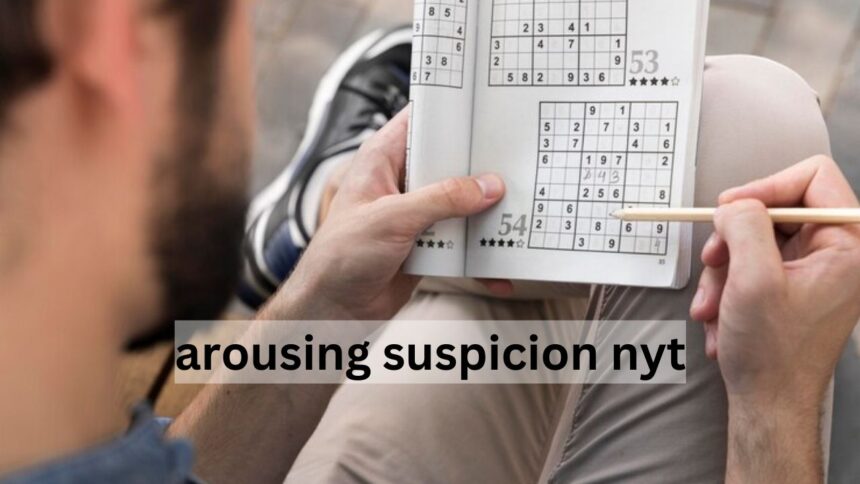Introduction to NYT Crossword Puzzles
If you’ve ever found yourself staring at a New York Times crossword puzzle, you know the thrill it brings. Each clue offers a challenge that tickles your brain and draws you deeper into a world of words. Among those clues, “Arousing Suspicion NYT” stands out as particularly intriguing. What does it mean? How do we solve it? The excitement lies in deciphering these cryptic hints while racing against time.
Crossword puzzles are more than just games; they’re a mental workout. With every filled square, there’s an exhilarating sense of accomplishment. Whether you’re a seasoned pro or just starting out, understanding how to tackle clues like “Arousing Suspicion NYT” can elevate your crossword-solving game to new heights. Let’s dive into the art and strategy behind uncovering hidden meanings within this beloved pastime!
Understanding Clues and Answers
Crossword puzzles are a delightful blend of language and logic. Each clue is crafted to challenge your knowledge while teasing your wit. Understanding these clues is essential for unlocking the answers.
Clues can vary greatly in style. Some may be straightforward, while others require lateral thinking or specialized knowledge. The phrase “Arousing Suspicion NYT” might lead you down multiple paths, depending on how it’s interpreted.
Pay attention to wording and punctuation; they often reveal hints about the answer’s length or type—be it a noun, verb, or adjective. This insight helps narrow down possibilities effectively.
Context matters too. Clues may reference pop culture, history, or even wordplay. Familiarizing yourself with common themes can provide an edge when deciphering tricky lines in the grid. Embrace the nuances of each clue; they hold many secrets waiting to be uncovered.
Explanation of
When tackling the clue “Arousing Suspicion NYT,” it’s essential to think about the emotions and actions that evoke doubt or mistrust. This may lead you to consider words related to skepticism.
Often, synonyms play a crucial role in crossword puzzles. For this particular clue, terms like “dubious” or “suspicious” itself might come to mind.
Considering phrases can also be helpful; expressions such as “raising eyebrows” could fit into the puzzle’s grid if it’s within the right letter count.
Don’t forget context! The surrounding clues often provide critical hints on which direction your thinking should go. Each letter counts, both literally and figuratively.
Stay open-minded and let your thoughts flow freely while exploring different possibilities. Your instincts will guide you through those tricky pathways of wordplay.
Possible Answers for the Clue
When it comes to the clue “Arousing Suspicion NYT,” several answers could fit, depending on context.
One likely candidate is “SUSPECT.” This word perfectly encapsulates a feeling of doubt or mistrust. It’s often used in crime-related scenarios, which adds depth to its meaning.
Another possible answer could be “EERIE.” This term invokes an unsettling atmosphere that raises red flags in various situations—great for capturing that feeling of suspicion.
“DOUBT” is another contender. Simple yet powerful, it reflects uncertainty and can apply broadly to personal interactions or larger contexts.
Consider “CREEPY.” This evocative choice embodies something unsettling enough to make one question motives or actions.
Each potential answer brings unique nuances tied closely with the idea of suspicion and intrigue within crossword puzzles.
Tips for Solving Tricky Clues
When tackling tricky crossword clues, patience is key. Take a deep breath and don’t rush the process.
Start by looking at the surrounding answers. They often provide context that can unlock difficult clues. Focus on any letters you already have; they might inspire an idea or two.
Next, think outside the box. Crossword clues sometimes play with words in unexpected ways. Consider synonyms or even homophones when brainstorming possible answers.
Don’t hesitate to use your resources. A good dictionary or thesaurus can be invaluable for finding those elusive words that fit perfectly into your grid.
Practice makes perfect! The more puzzles you solve, the better you’ll become at recognizing common themes and clever wordplay used by constructors. Enjoy the challenge!
The Art of Crossword Puzzles: Strategies and Techniques
Crossword puzzles are a blend of art and intellect. As you tackle each clue, think beyond the obvious. Look for synonyms or related terms that might fit.
One effective strategy is to fill in the easier clues first. This builds momentum and often reveals letters for trickier ones. Don’t hesitate to pencil in guesses; they can guide your thought process.
Patterns play a crucial role too. Familiarize yourself with common crossword lingo, like abbreviations or recurring themes. These insights can make challenging clues seem less daunting.
Consider the grid’s structure as well—some words intersect more frequently than others, offering additional hints about potential answers.
Practice patience and allow your mind to wander when stuck. Sometimes stepping away allows fresh ideas to surface unexpectedly!
Conclusion
Crossword puzzles offer a delightful blend of challenge and entertainment. They engage our minds and keep us sharp. The clue “Arousing Suspicion NYT” is just one example of how these puzzles can stump even seasoned solvers.
By understanding the intricacies of crossword clues, you equip yourself with the tools to tackle them more effectively. With possible answers like “SUSPECT,” solving becomes less daunting when you know what you’re looking for.
Remember that practice makes perfect. Embrace tricky clues as opportunities to learn rather than roadblocks in your puzzle journey. Use strategies like filling in known letters first or working with themes to simplify complex grids.
As you continue honing your skills, you’ll find satisfaction not just in completing a puzzle but also in mastering the art of deduction that comes with each new challenge presented by those clever constructors at the New York Times. Keep solving and let curiosity guide your way through every grid!




